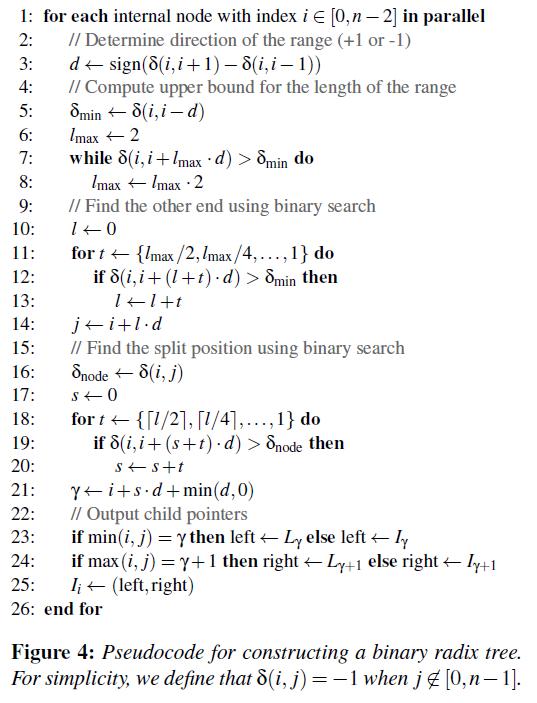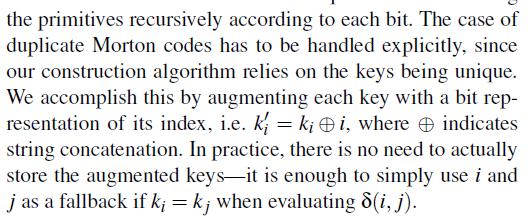Construct BVH with Unity Job System | 用Unity JobSystem构造BVH
Nov 20, 2018
BVH https://en.wikipedia.org/wiki/Bounding_volume_hierarchy 是一种空间存储数据结构,便于空间查找。类似的空间查找方法还有BSP,OcTree等等。
BVH的构造/查询比较快,空间冗余也比较少,在实时图形学领域用的比较广泛。比如NVidia的RTX技术,就是固定管线实现了BVH便于RayTracing加速。https://devblogs.nvidia.com/nvidia-turing-architecture-in-depth/
BVH是有并行算法的,也就便于利用Unity JobSystem多线程构造。
本来想抄ECSPhysics代码的代码,但是发现它构造出来的BVH有bug….
于是基本参考了Thinking Parallel, Part III: Tree Construction on the GPU这篇经典文章https://devblogs.nvidia.com/thinking-parallel-part-iii-tree-construction-gpu/ ,自己在Unity中实现
构造BVH对于剔除,物理,swarm通信都是很重要的。
基本的流程:1. 构造ZOrder 2. 排序 3 构造子节点 4 构造内部节点 5 更新AABB
1. ZOrder Curve & Morton Code 是一种将多维数据降为一维的方法,降为一维的好处是便于排序,便于存储。用这种方法将场景物体排序后再并行构造BVH会比较方便
https://en.wikipedia.org/wiki/Z-order_curve
ECSPhysics里是有计算MortonCode的方法的,Tree Construction on the GPU原文里也有
https://github.com/PhilSA/ECSPhysics
自然就直接抄过来了。需要注意的是xyz只有10bit的空间,对大量物体是不够用的,这也会出现mortoncode相同的情况,后面会遇到这个问题。
注意CalculateMortonCode要输入一个0-1的向量,上面ECSPhysics似乎代码写错了
1 2 3 4 5 6 7 8 9 10 11 12 13 14 15 16 17 18 19 20 [MethodImpl(MethodImplOptions.AggressiveInlining)] public static uint ExpandBits(uint v) { v = (v * 0x00010001u) & 0xFF0000FFu; v = (v * 0x00000101u) & 0x0F00F00Fu; v = (v * 0x00000011u) & 0xC30C30C3u; v = (v * 0x00000005u) & 0x49249249u; return v; } [MethodImpl(MethodImplOptions.AggressiveInlining)] public static uint CalculateMortonCode(float3 vector) { vector.x = math.min(math.max(vector.x * 1024.0f, 0.0f), 1023.0f); vector.y = math.min(math.max(vector.y * 1024.0f, 0.0f), 1023.0f); vector.z = math.min(math.max(vector.z * 1024.0f, 0.0f), 1023.0f); uint xx = ExpandBits((uint) vector.x); uint yy = ExpandBits((uint) vector.y); uint zz = ExpandBits((uint) vector.z); return (xx * 4 + yy * 2 + zz); }
对于Y方向变化不大的情况可以用2D的版本,这样xz各有16bit,大大减少morton code相同的情况。
1 2 3 4 5 6 7 8 9 10 11 12 13 14 15 16 17 18 19 20 21 22 23 [MethodImpl(MethodImplOptions.AggressiveInlining)] public static uint ExpandBits2D(uint v) { v &= 0x0000ffff; v |= (v << 8); v &= 0x00ff00ff; v |= (v << 4); v &= 0x0f0f0f0f; v |= (v << 2); v &= 0x33333333; v |= (v << 1); v &= 0x55555555; return v; } [MethodImpl(MethodImplOptions.AggressiveInlining)] public static uint CalculateMortonCode2D(float3 vector) { vector.x = math.min(math.max(vector.x * 65536.0f, 0.0f), 65536.0f); vector.z = math.min(math.max(vector.z * 65536.0f, 0.0f), 65535.0f); uint xx = ExpandBits2D((uint)vector.x); uint zz = ExpandBits2D((uint)vector.z); return (xx * 2 + zz); }
2. 排序 ECSPhysics代码里用Radix单线程排的序,Profile看这也是性能瓶颈之一,一核有难七核围观
并行排序可以考虑Bitonic Sort,时间复杂度是o(log(n)^2)。很好的是每个pass不会有dataracing的。原理和双调序列的特性相关,有Batcher定理:这篇文章讲的很好,三十分钟理解:双调排序Bitonic Sort,适合并行计算的排序算法
https://blog.csdn.net/xbinworld/article/details/76408595
于是笔者用Job实现了Bitonic Sort。比较麻烦的是Job好像不能递归调用,只能一个pass开一个job了
1 2 3 4 5 6 7 8 9 10 11 12 13 14 15 16 17 18 19 20 21 22 23 24 25 26 27 28 29 30 31 32 33 34 35 36 37 38 39 40 41 42 43 44 45 46 47 48 49 50 51 52 53 54 55 [BurstCompile] struct BitonicMergeJob : IJobParallelFor { [NativeDisableParallelForRestriction] public NativeArray<uint> values; [NativeDisableParallelForRestriction] public NativeArray<int> indexConverter; public int strideSwap; public int strideRisingGroup; public void Execute(int index) { int swapPairId = index / strideSwap; int swapGroupId = index - swapPairId * strideSwap; int swapGroupStartId = swapPairId * 2 * strideSwap; int swapIdFirst = swapGroupStartId + swapGroupId; int swapIdSecond = swapIdFirst + strideSwap; int risingGroupId = swapPairId / strideRisingGroup; bool rising = risingGroupId % 2 == 0 ? true : false; if (values[swapIdFirst] > values[swapIdSecond] == rising) { uint tempValue = values[swapIdFirst]; int tempId = indexConverter[swapIdFirst]; values[swapIdFirst] = values[swapIdSecond]; indexConverter[swapIdFirst] = indexConverter[swapIdSecond]; values[swapIdSecond] = tempValue; indexConverter[swapIdSecond] = tempId; } } } [BurstCompile] struct BitonicSortJob : IJobParallelFor { [NativeDisableParallelForRestriction] public NativeArray<uint> values; [NativeDisableParallelForRestriction] public NativeArray<int> indexConverter; public int strideSwap; public void Execute(int index) { int swapPairId = index / strideSwap; int swapGroupId = index - swapPairId * strideSwap; int swapGroupStartId = swapPairId * 2 * strideSwap; int swapIdFirst = swapGroupStartId + swapGroupId; int swapIdSecond = swapIdFirst + strideSwap; if (values[swapIdFirst] > values[swapIdSecond]) { uint tempValue = values[swapIdFirst]; int tempId = indexConverter[swapIdFirst]; values[swapIdFirst] = values[swapIdSecond]; indexConverter[swapIdFirst] = indexConverter[swapIdSecond]; values[swapIdSecond] = tempValue; indexConverter[swapIdSecond] = tempId; } } }
调用是在JobComponentSystem里
1 2 3 4 5 6 7 8 9 10 11 12 13 14 15 16 17 18 19 20 21 22 23 24 25 var bitonicMergeJob = new BitonicMergeJob() { values = mortonCodes, indexConverter = indexConverter }; var bitonicSortJob = new BitonicSortJob() { indexConverter = indexConverter, values = mortonCodes }; int pass = (int)math.log2(mortonCodes.Length); for (int i = 0; i < pass - 1; i++) { for (int j = 0; j <= i; j++) { bitonicMergeJob.strideSwap = 1 << (i - j); bitonicMergeJob.strideRisingGroup = 1 << j; deps = bitonicMergeJob.Schedule(mortonCodes.Length / 2, 64, deps); } } for (int i = 0; i < pass; i++) { bitonicSortJob.strideSwap = 1 << (pass - i - 1); deps = bitonicSortJob.Schedule(mortonCodes.Length / 2, 64, deps); }
Profile看确实比原来的单线程快一些,但可能有线程调用和开销,也不是很理想。
3. 构造子节点 没有什么技术含量,这里就不放代码了
4. 构造内部节点 karras原文里放了伪码,Tree Construction on the GPU里面也放了C++的代码。但是determineRange(i),这个函数代码没给出来。
其实主要划分成三步
determinrange
findsplit
output
第一步找到split可能出现的范围,第二步binary search找split,第三步输出
其实也好实现,照抄伪码就行。这步是很神的。先binary往前找最远的range,再binary往回找最近的range。
1 2 3 4 5 6 7 8 9 10 11 12 13 14 15 16 17 18 19 20 21 22 23 int2 determineRange(int i) { int d = (clz_safe(i, i + 1) - clz_safe(i, i - 1)) > 0 ? 1 : -1; int commonPrefixMin = clz_safe(i, i - d); int l_max = 2; while (clz_safe(i, i + d * l_max) > commonPrefixMin) { l_max *= 2; } int l = 0; int t = l_max; do { t = (t + 1) >> 1; // exponential decrease if (clz_safe(i, i + d * (l + t)) > commonPrefixMin) { l += t; } } while (t > 1); int j = i + l * d; int2 range = d > 0 ? new int2(i, j) : new int2(j, i); return range; }
这时会遇到一个大坑,clz的计算。__clz是C++原生的,c#里只能面向stackoverflow
1 2 3 4 5 6 7 8 9 10 11 12 13 14 15 16 17 18 19 //https://stackoverflow.com/questions/10439242/count-leading-zeroes-in-an-int32 [MethodImpl(MethodImplOptions.AggressiveInlining)] private int clz_value(uint value1, uint value2) { uint value = value1 ^ value2; //do the smearing value |= value >> 1; value |= value >> 2; value |= value >> 4; value |= value >> 8; value |= value >> 16; //count the ones value -= ((value >> 1) & 0x55555555); value = (((value >> 2) & 0x33333333) + (value & 0x33333333)); value = (((value >> 4) + value) & 0x0f0f0f0f); value += (value >> 8); value += (value >> 16); return (int)(32 - (value & 0x0000003f)); }
然后又会遇到一个大坑,mortoncode一样怎么办???
如果mortoncode一样的话构造bvh时,determinrange和findsplit都会出错,最后树节点上会有环,没法更新aabb了。
论文里第四节有讲, //https://devblogs.nvidia.com/parallelforall/wp-content/uploads/2012/11/karras2012hpg_paper.pdf
一样的话用index算一下。
1 2 3 4 5 6 7 8 9 10 11 12 13 14 private int clz_safe(int idx, int idy) { if (idy < 0 || idy > NumObjects - 1) return -1; return clz_index(idx, idy); } [MethodImpl(MethodImplOptions.AggressiveInlining)] private int clz_index(int idx, int idy) { //rely on morton being unique, otherwise clz its index //see section 4. BVHs, Octrees, and k-d Trees return mortonCodes[idx] == mortonCodes[idy] ? (NumObjects - math.max(idx, idy)) + 32 : clz_value(mortonCodes[idx], mortonCodes[idy]); }
5. 更新AABB bottom-up更新,第一个到的节点退出。这里理应有一锁,避免datarace。实际应用中不太会写,目前这样偶尔会出错但一般问题不大。
1 2 3 4 5 6 7 8 9 10 11 12 13 14 15 16 17 18 19 20 21 22 23 24 25 26 27 28 29 30 31 32 33 34 [BurstCompile] unsafe struct UpdateAABBJob : IJobParallelFor { [NativeDisableParallelForRestriction] public NativeArray<BVHNode> BVHArray; [NativeDisableUnsafePtrRestriction] public long* locks; public void Execute(int i) { int halfLength = BVHArray.Length / 2; int leafNodeId = halfLength + i; AABB leafNodeAABB = BVHArray[leafNodeId].aabb; int parentIndex = BVHArray[leafNodeId].ParentNodeIndex; while (parentIndex != -1) { //todo locks! BVHNode parent = BVHArray[parentIndex]; if (parent.IsValid < 1) { parent.aabb = leafNodeAABB; parent.IsValid = 1; BVHArray[parentIndex] = parent; break; } else { parent.aabb = Utils.GetEncompassingAABB(parent.aabb, leafNodeAABB); parent.IsValid = 2; BVHArray[parentIndex] = parent; } leafNodeAABB = parent.aabb; parentIndex = parent.ParentNodeIndex; } } }
计算方法https://www.forceflow.be/2013/10/07/morton-encodingdecoding-through-bit-interleaving-implementations/
Morton Code
https://www.forceflow.be/2013/10/07/morton-encodingdecoding-through-bit-interleaving-implementations/
https://github.com/Forceflow/libmorton/blob/master/libmorton/include/morton2D.h
https://github.com/aperley/parallel-bvh
https://devblogs.nvidia.com/thinking-parallel-part-iii-tree-construction-gpu/
ECSPhysics
https://docs.google.com/document/d/14IwE_A3mC5clYs8XuQ8mXDCO0NhAEPW0ziczVarmr4Q/edit#
https://github.com/PhilSA/ECSPhysics

